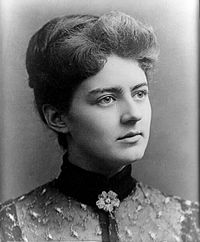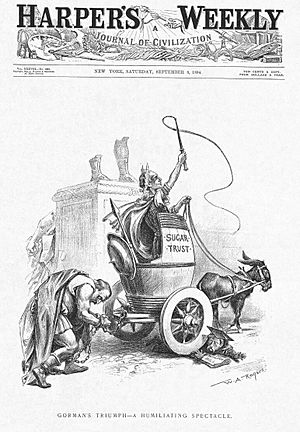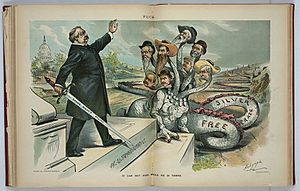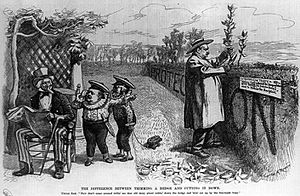Presidencies of Grover Cleveland facts for kids
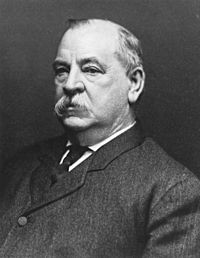 |
|
Quick facts for kids
Presidencies of Grover Cleveland
|
|
|---|---|
| Party | Democratic |
| Seat | White House |
| First term | |
| March 4, 1885 – March 4, 1889 | |
| Cabinet | See list |
| Election | 1884 |
|
← Chester A. Arthur • Benjamin Harrison →
|
|
| Second term | |
| March 4, 1893 – March 4, 1897 | |
| Cabinet | See list |
| Election | 1892 |
|
← Benjamin Harrison • William McKinley →
|
|
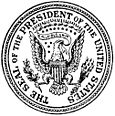 |
|
| Seal of the President (1894–1945) |
|
Grover Cleveland served as the president of the United States for two separate terms. His first term was from March 4, 1885, to March 4, 1889. His second term was from March 4, 1893, to March 4, 1897. He was the first Democrat elected after the Civil War. Cleveland is also the only US president to leave office after one term and then return for a second term. He was the nation's 22nd and 24th president.
In 1884, Cleveland won against James G. Blaine. He then lost to Benjamin Harrison in 1888. However, he defeated President Harrison in 1892 to win his second term.
During his first term, Cleveland worked on government reforms. He signed the Interstate Commerce Act of 1887. This law created the first independent federal agency to regulate railroads. In foreign policy, the Samoan crisis was a big event. It ended with three countries sharing control of the Samoan Islands.
His second presidency began during a severe economic downturn called the Panic of 1893. Cleveland worked to change money policies and lower tariffs. He also used federal soldiers to end the Pullman Strike. In foreign policy, he stopped the annexation of Hawaii. He also made Great Britain agree to a border dispute with Venezuela. Cleveland left office unpopular. However, historians later recognized his role in making the presidency stronger.
Contents
- How Cleveland Won the 1884 Election
- Cleveland's First Presidency (1885–1889)
- Cleveland's Administration and Cabinet
- Cleveland's Marriage and Family
- Reforming Government Jobs
- Regulating Railroads with the Interstate Commerce Act
- Cleveland's Use of Vetoes
- Money Policy: Gold vs. Silver
- Tariff Debates
- Foreign Policy in Cleveland's First Term
- Military Modernization
- Civil Rights and Immigration Policies
- Indian Policy and Land Rights
- Supreme Court Appointments
- The 1888 Election: Cleveland Loses to Harrison
- Cleveland's Return: The 1892 Election
- Cleveland's Second Presidency (1893–1897)
- Cleveland's Second Cabinet
- Cleveland's Secret Surgery
- Economic Crisis and Silver Money
- Labor Unrest: Coxey's Army and the Pullman Strike
- Tariff Problems Continue
- Civil Rights and Voting
- The 1894 Elections and Party Changes
- Foreign Policy in Cleveland's Second Term
- Military Policy in Cleveland's Second Term
- Judicial Appointments and Senate Conflicts
- The 1896 Election: Bryan and McKinley
- New States Admitted to the Union
- Cleveland's Place in History
How Cleveland Won the 1884 Election
Grover Cleveland became well-known for wanting to reform the government. After winning the 1882 New York governor election, he was seen as a possible presidential candidate. Many Democrats wanted him to run.
At the 1884 Democratic National Convention, Cleveland faced other strong candidates. But each had problems that made them less popular. Cleveland had his own opponents, like the Tammany Hall political group. However, the fact that he stood up to them made him more popular with many voters. He also had strong support from New York party leaders. Cleveland won the nomination quickly, and Thomas A. Hendricks became his running mate.
The 1884 Republican National Convention chose James G. Blaine as their candidate. Many Republicans who wanted reform, called "Mugwumps," did not like Blaine. They thought he was too focused on his own power and not honest. These Mugwumps decided to support Cleveland instead.
The election focused on political corruption. Blaine had been involved in some questionable deals. Cleveland's reputation as someone who fought corruption was a big advantage for the Democrats. Cleveland mostly stayed home during the campaign. Blaine, however, traveled and gave many speeches.
Cleveland won the Southern states, which was expected. Blaine won most of New England and the Midwest. The election came down to a few key states: New York, New Jersey, Indiana, and Connecticut. Cleveland won all four of these states by a small number of votes. He won his home state of New York by only 1,200 votes. Cleveland won the national popular vote by a small margin. He also won the electoral vote 219 to 182. This made him the first Democrat to win the presidency since the Civil War.
Cleveland's First Presidency (1885–1889)
Cleveland became the 22nd president on March 4, 1885. His Vice President, Thomas A. Hendricks, died later that year. At that time, there was no rule to replace a vice president during their term. So, the position remained empty.
Cleveland's Administration and Cabinet
| The First Cleveland Cabinet | ||
|---|---|---|
| Office | Name | Term |
| President | Grover Cleveland | 1885–1889 |
| Vice President | Thomas A. Hendricks | 1885 |
| none | 1885–1889 | |
| Secretary of State | Thomas F. Bayard | 1885–1889 |
| Secretary of Treasury | Daniel Manning | 1885–1887 |
| Charles S. Fairchild | 1887–1889 | |
| Secretary of War | William Crowninshield Endicott | 1885–1889 |
| Attorney General | Augustus Hill Garland | 1885–1889 |
| Postmaster General | William Freeman Vilas | 1885–1888 |
| Donald M. Dickinson | 1888–1889 | |
| Secretary of the Navy | William Collins Whitney | 1885–1889 |
| Secretary of the Interior | Lucius Quintus Cincinnatus Lamar | 1885–1888 |
| William Freeman Vilas | 1888–1889 | |
| Secretary of Agriculture | Norman Jay Coleman | 1889 |
Cleveland had to choose the first Democratic cabinet since the 1850s. None of his choices had served in a presidential cabinet before. He picked Thomas F. Bayard as Secretary of State. Daniel Manning became Secretary of the Treasury. William C. Whitney was appointed Secretary of the Navy. Cleveland also chose two Southerners for his cabinet.
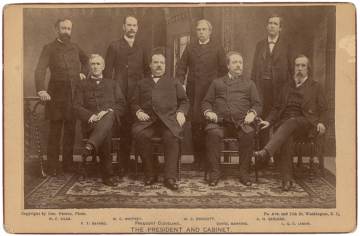
Front row, left to right: Thomas F. Bayard, Cleveland, Daniel Manning, Lucius Q. C. Lamar
Back row, left to right: William F. Vilas, William C. Whitney, William C. Endicott, Augustus H. Garland
Cleveland's Marriage and Family
Cleveland was a bachelor when he became president. His sister, Rose Cleveland, served as the White House hostess for two years. On June 2, 1886, Cleveland married Frances Folsom in the White House. She was 21 years old, making her the youngest First Lady in history. The public liked her beauty and friendly personality.
Reforming Government Jobs
Before Cleveland, many government jobs were given based on political favors. This was called the "spoils system." Cleveland announced he would not fire Republicans who were doing a good job. He also said he would not hire people just because they were from his party. Later, he did replace some Republican officials with Democrats.
Cleveland also increased the number of federal jobs that were based on merit, not politics. This was under the Pendleton Civil Service Reform Act. The percentage of federal employees protected by this act grew from 12% to 40% during his and the next president's terms.
Cleveland also fought against the Tenure of Office Act. This law said the Senate had to approve the firing of any presidential appointee. Cleveland refused to follow it and would not give Congress documents about his appointments. He believed the president should have the power to fire his own appointees. This stance was popular with the public. The law was repealed in March 1887.
In 1889, Cleveland signed a bill that made the Department of Agriculture a cabinet-level department. He also ordered an investigation into railroad companies. This led to the government taking back millions of acres of land that the railroads had not used as agreed.
Regulating Railroads with the Interstate Commerce Act
In the 1880s, people wanted to control railroads more. They were angry about unfair practices, like charging different rates to different customers. Cleveland usually did not want the federal government to get involved in regulating businesses.
However, a Supreme Court case in 1886 limited states' power to regulate railroads. So, Cleveland agreed to a federal law. In 1887, he signed the Interstate Commerce Act of 1887. This law created the Interstate Commerce Commission (ICC). The ICC was a group of five people who would investigate railroad practices. They were supposed to make sure railroads charged fair rates. This act was the first federal law to regulate a private industry in the US. The ICC was also the first independent federal agency.
Cleveland's Use of Vetoes
Cleveland used his veto power more than any president before him. He vetoed hundreds of bills that would have given pensions to Civil War veterans. He believed that if the Pension Bureau had already rejected a request, Congress should not overrule that decision.
In 1887, Cleveland made his most famous veto, the Texas Seed Bill. A severe drought had hurt many farmers in Texas. Congress passed a bill to give $10,000 to buy seeds for these farmers. Cleveland vetoed this bill. He believed the government should not directly help individuals in this way. He said:
I can find no warrant for such an appropriation in the Constitution, and I do not believe that the power and duty of the general government ought to be extended to the relief of individual suffering which is in no manner properly related to the public service or benefit. A prevalent tendency to disregard the limited mission of this power and duty should, I think, be steadfastly resisted, to the end that the lesson should be constantly enforced that, though the people support the government, the government should not support the people. The friendliness and charity of our countrymen can always be relied upon to relieve their fellow-citizens in misfortune. This has been repeatedly and quite lately demonstrated. Federal aid in such cases encourages the expectation of paternal care on the part of the government and weakens the sturdiness of our national character, while it prevents the indulgence among our people of that kindly sentiment and conduct which strengthens the bonds of a common brotherhood.
Money Policy: Gold vs. Silver
A big debate in the 1880s was about what should back the nation's money. Some wanted money backed by both gold and silver. Others wanted it backed by gold alone. This issue divided both political parties. People in the West and South often favored silver, while those in the Northeast favored gold.
Cleveland believed that using only gold would keep the currency stable. He also thought it was fair to those who had given loans. He tried to reduce the amount of silver the government had to coin under the Bland–Allison Act of 1878. He also tried to get Congress to repeal this law, but he was not successful. The debate over gold and silver continued for many years.
Tariff Debates
| When we consider that the theory of our institutions guarantees to every citizen the full enjoyment of all the fruits of his industry and enterprise, with only such deduction as may be his share toward the careful and economical maintenance of the Government which protects him, it is plain that the exaction of more than this is indefensible extortion and a culpable betrayal of American fairness and justice ... The public Treasury, which should only exist as a conduit conveying the people's tribute to its legitimate objects of expenditure, becomes a hoarding place for money needlessly withdrawn from trade and the people's use, thus crippling our national energies, suspending our country's development, preventing investment in productive enterprise, threatening financial disturbance, and inviting schemes of public plunder. |
| -- Cleveland's third annual message to Congress, December 6, 1887. |
Tariff rates had increased a lot during the Civil War. By the 1880s, the government had a lot of extra money because of these high tariffs. Cleveland and most Democrats wanted to lower tariffs. Cleveland believed high tariffs unfairly helped some industries and made prices higher for consumers. Republicans, however, wanted high tariffs to protect American businesses from foreign competition.
Cleveland pushed for lower tariffs in his messages to Congress. He warned that too much money in the government's treasury could cause financial problems. Despite his efforts, no major tariff bill passed during his first term. The debate over tariffs became a big issue in the 1888 presidential election.
Foreign Policy in Cleveland's First Term
Cleveland believed in not getting involved in other countries' affairs. He opposed expanding American power. He did not support a treaty that would have allowed the US to build a canal in Nicaragua. However, he believed in the Monroe Doctrine, which aimed to protect American influence in the Western Hemisphere.
A major foreign policy event was the Samoan crisis. The US, Germany, and Great Britain all had interests in Samoa. Cleveland worried that Germany wanted to take over Samoa. The US supported a local leader, which led to conflict. Germany threatened war, but backed down. Later, the three countries agreed to share control of Samoa.
Military Modernization
Cleveland focused on making the military stronger for self-defense. In 1885, he created a board to improve coastal defenses. Most of their recommendations were put into action. By 1910, 27 locations were protected by over 70 forts.
The Navy also began to modernize. They ordered 16 new steel-hulled warships by 1888. These ships were very important later in the Spanish–American War of 1898. They included battleships like the Maine and Texas.
Civil Rights and Immigration Policies
Cleveland, like many Northerners and most white Southerners, believed that Reconstruction had not worked. He did not use federal power to enforce the Fifteenth Amendment, which gave voting rights to African-Americans.
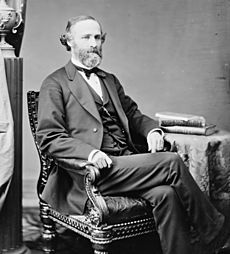
Cleveland generally did not support strict immigration limits. However, he came to believe that Chinese immigrants would not fit into American society. He signed the Scott Act in 1888. This law prevented Chinese immigrants who left the US from returning.
Indian Policy and Land Rights
About 250,000 Native Americans lived in the US when Cleveland took office. Cleveland saw Native Americans as needing government protection. He supported the Dawes Act. This law aimed to divide tribal lands among individual Native Americans. Cleveland thought this would help them out of poverty and fit into white society. However, it actually weakened tribal governments and led to Native Americans losing millions of acres of land.
In 1885, Cleveland canceled an order by the previous president that opened Native American lands in the Dakota Territory to white settlers. He believed this order violated treaties. He sent Army troops to remove the settlers and enforce the treaties.
Supreme Court Appointments
During his first term, Cleveland appointed two justices to the Supreme Court of the United States. After Justice William Burnham Woods died, Cleveland nominated Interior Secretary Lucius Q.C. Lamar. Lamar had served in the Confederacy, so some Republicans voted against him. But his nomination was approved by a close vote.
When Chief Justice Morrison Waite died in 1888, Cleveland nominated Melville Fuller. The Senate took several months to review Fuller. He was confirmed and served as Chief Justice until 1910.
The 1888 Election: Cleveland Loses to Harrison
Cleveland was easily nominated for re-election by the Democrats. Since Vice President Hendricks had died, Allen G. Thurman became his new running mate. The Republicans nominated Benjamin Harrison.
Republicans focused their campaign on the tariff issue. They argued that high tariffs protected American jobs. Democrats in New York were divided, which hurt Cleveland's support. Cleveland's campaign was not well organized. Many reform-minded Republicans, the Mugwumps, also stopped supporting Cleveland. They were disappointed that he had not made more civil service reforms.
Like in 1884, the election came down to a few swing states. Cleveland won most of the states he had won in 1884. However, he lost Indiana and his home state of New York to Harrison. Even though Cleveland won the national popular vote by a small margin, losing New York's electoral votes cost him the election. Republicans also won control of the House of Representatives. This gave them control of both houses of Congress for the first time in years.
Cleveland's Return: The 1892 Election
After losing in 1888, Cleveland went back to New York and worked as a lawyer. He became a strong candidate for the 1892 election. He spoke out against the growing "Free Silver" movement in the Democratic Party. His main opponent for the nomination was Senator David B. Hill. Hill tried to unite all the groups against Cleveland. But Cleveland still won the nomination on the first try.
For Vice President, the Democrats chose Adlai Stevenson I. He was a "silverite," meaning he supported using silver to back money. This balanced the ticket with Cleveland, who supported the gold standard. The Republicans re-nominated President Harrison, making it a rematch of the 1888 election.
The issue of tariffs, which helped Republicans in 1888, now worked against them. Imported goods had become very expensive. Many voters wanted tariff reform. Also, a new party, the Populist Party, gained support in the West. Their candidate, James B. Weaver, promised "Free Silver" and other reforms.
Cleveland won 46% of the popular vote and 62.4% of the electoral vote. He became the only president to win two non-consecutive terms. Harrison won 43% of the popular vote. Weaver won 8.5% of the popular vote and some electoral votes in Western states. Cleveland won the South and key swing states like New York. Democrats also won control of both the House and Senate. This gave them full control of Congress and the presidency for the first time since the Civil War.
Cleveland's Second Presidency (1893–1897)
Cleveland became the 24th president on March 4, 1893. Stevenson was sworn in as vice president on the same day.
Cleveland's Second Cabinet
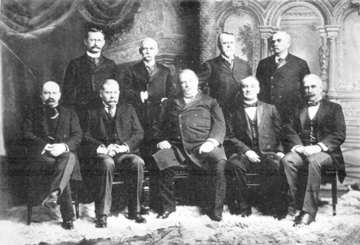
Front row, left to right: Daniel S. Lamont, Richard Olney, Cleveland, John G. Carlisle, Judson Harmon
Back row, left to right: David R. Francis, William L. Wilson, Hilary A. Herbert, Julius S. Morton
| The Second Cleveland Cabinet | ||
|---|---|---|
| Office | Name | Term |
| President | Grover Cleveland | 1893–1897 |
| Vice President | Adlai Stevenson I | 1893–1897 |
| Secretary of State | Walter Q. Gresham | 1893–1895 |
| Richard Olney | 1895–1897 | |
| Secretary of Treasury | John G. Carlisle | 1893–1897 |
| Secretary of War | Daniel S. Lamont | 1893–1897 |
| Attorney General | Richard Olney | 1893–1895 |
| Judson Harmon | 1895–1897 | |
| Postmaster General | Wilson S. Bissell | 1893–1895 |
| William Lyne Wilson | 1895–1897 | |
| Secretary of the Navy | Hilary A. Herbert | 1893–1897 |
| Secretary of the Interior | M. Hoke Smith | 1893–1896 |
| David R. Francis | 1896–1897 | |
| Secretary of Agriculture | Julius Sterling Morton | 1893–1897 |
Cleveland chose a new cabinet for his second term. Daniel S. Lamont became Secretary of War. Walter Q. Gresham, a former Republican, became Secretary of State. Richard Olney was appointed Attorney General. John G. Carlisle became Secretary of the Treasury.

Cleveland's Secret Surgery
In 1893, Cleveland had a secret surgery to remove a tumor in his mouth. He kept it secret to avoid causing more panic during a financial depression. The surgery happened on a yacht off Long Island. Doctors operated through his mouth to avoid any visible scars. A fake story was released to the press about him having two bad teeth removed. The public did not learn about the surgery until 1917.
Economic Crisis and Silver Money
Soon after Cleveland's second term began, the Panic of 1893 hit the stock market. This caused a severe economic depression. The panic started with a railroad company failing. But other issues contributed, like European investors pulling money out of the US. The US also did not have a central banking system to control the money supply.
Cleveland believed that using both gold and silver for money caused problems. He thought it made people hoard gold. He argued that only using the gold standard would help the economy. He called a special session of Congress to repeal the Sherman Silver Purchase Act. This act required the government to buy silver.
The debate was very heated. Cleveland worked hard to convince Congress to repeal the act. Finally, a combination of Democrats and Republicans supported the repeal. This marked the beginning of the end for silver as a basis for American money.
However, repealing the act did not fix the economy. Many banks and businesses failed. Unemployment rose above 20% in some areas. In 1894, Cleveland had to ask a group of bankers, led by J. P. Morgan, to buy US bonds. This brought gold into the economy and helped keep the gold standard. But Cleveland was criticized for relying on powerful bankers. The economy remained bad throughout his second term.
Labor Unrest: Coxey's Army and the Pullman Strike
The economic depression led to bad working conditions. In 1894, a group of unemployed men, called Coxey's Army, marched to Washington, D.C. They wanted the government to create jobs and change money policies. The Army was stopped by federal troops.
Later, the Pullman Strike began. Railroad companies cut workers' wages. The American Railway Union (ARU), led by Eugene V. Debs, organized strikes. The strikes spread and stopped much of the nation's trade. Because the railroads carried mail, Cleveland believed the federal government had to act.
Cleveland got a court order against the strikers. When they refused to obey, he sent federal troops to Chicago and other rail centers. He said, "If it takes the entire army and navy of the United States to deliver a postcard in Chicago, that card will be delivered." The governor of Illinois protested, saying Cleveland was overstepping his power. Cleveland was the first president to send soldiers to a labor dispute without a state governor's request. His actions were supported by many newspapers. However, they made organized labor angry.
Tariff Problems Continue
Democrats believed their 1892 election win meant they should lower tariffs. A bill was introduced to reduce tariffs, especially on raw materials. It also included an income tax on higher incomes. This would be the first federal income tax since the 1870s. Supporters hoped it would help reduce income inequality.
The bill passed the House. But in the Senate, it faced strong opposition. More than 600 changes were added to the bill, which removed most of the reforms. The Sugar Trust, a powerful business, lobbied for changes that helped them. The final bill, the Wilson–Gorman Tariff Act, lowered average tariff rates only slightly. Cleveland was very angry. He called it a "disgraceful product" of business interests. He allowed it to become law without his signature. The income tax part of the bill was later ruled unconstitutional by the Supreme Court.
Civil Rights and Voting
Cleveland did not support federal efforts to protect voting rights. In 1894, he signed a law that repealed the Enforcement Act of 1871. This act had provided federal oversight of elections. Cleveland also approved of the 1896 Supreme Court decision in Plessy v. Ferguson. This ruling allowed racial segregation under the "separate but equal" idea.
With the Supreme Court and federal government not protecting their rights, Southern states passed many Jim Crow laws. These laws used things like poll taxes and literacy tests to stop many African Americans from voting.
The 1894 Elections and Party Changes
Before the 1894 election, Cleveland was warned about public unhappiness. In these elections, Republicans won a huge victory. They took full control of the House of Representatives. Democrats lost seats everywhere except the South. Cleveland's opponents within the Democratic Party gained power in many states. For the last two years of his term, Cleveland faced a Republican-controlled Congress. Most Democrats in Congress were from the South and did not support Cleveland.
Foreign Policy in Cleveland's Second Term
| I suppose that right and justice should determine the path to be followed in treating this subject. If national honesty is to be disregarded and a desire for territorial expansion or dissatisfaction with a form of government not our own ought to regulate our conduct, I have entirely misapprehended the mission and character of our government and the behavior which the conscience of the people demands of their public servants. |
| -- Cleveland's message to Congress on the Hawaiian question, December 18, 1893. |
When Cleveland returned to office, he faced the issue of Hawaiian annexation. In early 1893, American and European businessmen in Honolulu overthrew Queen Liliuokalani. They set up a republic and wanted to join the United States. The previous president, Harrison, had quickly agreed to a treaty for annexation.
Five days after taking office, Cleveland withdrew the treaty from the Senate. He believed it was wrong to take over a small kingdom. He sent an investigator to Hawaii. This investigator suggested restoring the Queen. Cleveland tried to do this, but the Queen refused to grant amnesty to those who overthrew her. The new Hawaiian government also refused to give up power. Cleveland then left the issue to Congress. He encouraged the US to continue its tradition of not interfering. The Senate disagreed with Cleveland's investigator. Cleveland then recognized the new Republic of Hawaii. Hawaii was later annexed in 1898, after Cleveland left office.
Cleveland also used the Monroe Doctrine to assert American power. When Britain and Venezuela argued over a border, Cleveland protested. He said the US had an interest in any important matter in the Western Hemisphere. Britain eventually agreed to let an independent group decide the border.
The Cuban War of Independence began in 1895. Cuban rebels wanted to break free from Spanish rule. Many Americans wanted the US to help the rebels. But Cleveland did not support the rebel cause. He feared an independent Cuba might fall to another European power. He declared that the US would remain neutral.
Military Policy in Cleveland's Second Term
Cleveland's second administration also focused on modernizing the military. Construction continued on coastal defenses. The US Army also adopted its first modern repeating rifle. The Navy ordered five new battleships and sixteen torpedo boats. These ships greatly increased the Navy's strength. However, many of them were not finished until after the Spanish-American War.
Judicial Appointments and Senate Conflicts
Cleveland had trouble getting his Supreme Court nominations approved by the Senate in his second term. After a justice died in 1893, Cleveland nominated William B. Hornblower. But Senator David B. Hill, a political enemy of Cleveland, opposed him. Cleveland had also not consulted the Senators before making his choice. The Senate rejected Hornblower's nomination.
Cleveland then nominated Wheeler Hazard Peckham, another New York lawyer who opposed Hill. Hill again used his influence to block the nomination. The Senate rejected Peckham as well. Cleveland then chose Senator Edward Douglass White of Louisiana. White's nomination was accepted unanimously. Later, in 1896, Cleveland nominated Rufus Wheeler Peckham, Wheeler Hazard Peckham's brother. The Senate easily confirmed this nomination.
The 1896 Election: Bryan and McKinley
Cleveland tried to fight the growing "Free Silver" movement. But Democrats in the South and West rejected his economic policies. The Panic of 1893 had made Cleveland very unpopular, even within his own party. Cleveland did not plan to run for a third term.
Cleveland's opponents gained control of the 1896 Democratic National Convention. They rejected Cleveland's policies and the gold standard. They nominated William Jennings Bryan, who supported "Free Silver." Cleveland quietly supported a third-party ticket of "Gold Democrats." This group promised to defend the gold standard.
The 1896 Republican National Convention nominated William McKinley. McKinley focused his campaign on attacking Cleveland's handling of the economy. He argued that higher tariffs would bring back prosperity. Bryan attacked McKinley as a tool of the rich.
In the 1896 presidential election, McKinley won a clear victory over Bryan. He won 51% of the popular vote and 60.6% of the electoral vote. McKinley won most states in the Midwest and swept the Northeast. Bryan won the South. Cleveland was happy with McKinley's win. He saw it as proof that the gold standard was the right policy.
New States Admitted to the Union
From 1877 to 1888, Congress often rejected requests for statehood from Western territories. This was partly due to concerns about governance and balancing political power in the Senate.
However, in the final weeks of Cleveland's first term (February 1889), Congress passed a law. This law allowed North Dakota, South Dakota, Montana, and Washington to create constitutions and apply for statehood. All four became states in November 1889, during the start of Benjamin Harrison's presidency.
Midway through Cleveland's second term, in July 1894, Congress passed another act. This allowed Utah to form a constitution and apply for statehood. On January 4, 1896, Cleveland officially declared Utah a state.
Cleveland's Place in History
Historians have different views on Grover Cleveland. Some say he made the presidency stronger. But they also note that he did not have a clear vision for the country's future. He helped the Democratic Party become strong in the South. He also helped it in the North by supporting civil service reform.
When Cleveland left office in 1897, he was very unpopular. But his reputation improved greatly by the time he died in 1908. Some historians in the 1930s praised him as a brave reformer. They called him "the sole reasonable facsimile of a major president between Lincoln and Theodore Roosevelt."
However, later historians have looked more closely at his failures. They also noted his favoritism towards big businesses. In polls of historians, Cleveland's ranking has gone down over time. In a 1948 poll, he was ranked as the eighth greatest president. But a 2018 poll ranked him as the 24th best president. A 2017 C-SPAN poll ranked him 23rd.



